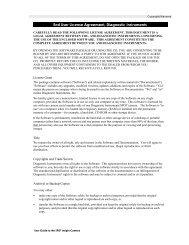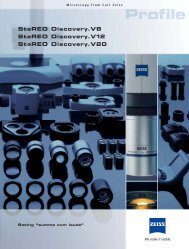optical interference filters - SPOT Imaging Solutions
optical interference filters - SPOT Imaging Solutions
optical interference filters - SPOT Imaging Solutions
You also want an ePaper? Increase the reach of your titles
YUMPU automatically turns print PDFs into web optimized ePapers that Google loves.
QuantaMAX Laser Edge<br />
Longpass Filters<br />
Angle Tuning Edge Filters<br />
All edge <strong>filters</strong> can be angle tuned to achieve optimal signal to noise.<br />
Angle tuning the filter will blue shift the transmission curve and allow<br />
Raman signals closer to the laser line to pass through the filter, at<br />
some expense to blocking, at the laser line. The filter can be oriented<br />
up to about 15°, normal normal incidence.<br />
At a 15° angle of incidence, the cut-on wavelength of the longpass<br />
edge filter will shift blue at approximately 1% of the cut on value<br />
at normal incidence. A filter that cuts on at 600nm with normal<br />
orientation will cut on at 594nm when tipped to 15°. A consequence<br />
of this blue shift is that the blocking at the laser line will decrease by<br />
approximately 2 levels of <strong>optical</strong> density.<br />
A secondary feature of angle tuning is that reflected energy is<br />
redirected from the <strong>optical</strong> axis. For longpass edge <strong>filters</strong>, select a<br />
filter with an edge that is to the red of the desired cut off and adjust<br />
the filter angle until optimal performance is achieved.<br />
For more than 40 years Omega Optical has been a leading<br />
manufacturer of high performance <strong>optical</strong> <strong>interference</strong> <strong>filters</strong> for a<br />
wide range of applications in Raman spectroscopy.<br />
Raman Spectroscopy General Overview<br />
Raman spectroscopy provides valuable structural information about<br />
materials. When laser light is incident upon a sample, a small<br />
percentage of the scattered light may be shifted in frequency. The<br />
frequency shift of the Raman scattered light is directly related to the<br />
structural properties of the material. A Raman spectrum provides a<br />
"fingerprint" that is unique to the material. Raman spectroscopy is<br />
employed in many applications including mineralogy, pharmacology,<br />
corrosion studies, analysis of semiconductors and catalysts, in situ<br />
measurements on biological systems, and even single molecule<br />
detection. Applications will continue to increase rapidly along with<br />
further improvements in the technology. A Raman signature provides<br />
positive material identification of unknown specimens to a degree<br />
that is unmatched by other spectroscopy's. Raman spectroscopy<br />
presents demanding requirements for the detection and resolution of<br />
narrow-bands of light with very low intensity and minimal frequency<br />
shift relative to the source. We are committed to supporting this<br />
science with <strong>optical</strong> coatings of the highest phase thickness and<br />
resulting superior performance.<br />
Raman Scattering<br />
When a probe beam of radiation described by an electric field<br />
E interacts with a material, it induces a dipole moment, μ, in the<br />
molecules that compose the material: μ = a x E where a is the<br />
polarizability of the molecule. The polarizability is a proportionality<br />
constant describing the deformability of the molecule. In order for<br />
a molecule to be Raman-active, it must possess a molecular bond<br />
with a polarizability that varies as a function of interatomic distance.<br />
Light striking a molecule with such a bond can be absorbed and then<br />
re-emitted at a different frequency (Raman-shifted), corresponding<br />
to the frequency of the vibrational mode of the bond. If the molecule<br />
is in its ground state upon interaction with the probe beam, the light<br />
can be absorbed and then re-emitted at a lower frequency, since<br />
energy from the light is channeled into the vibrational mode of the<br />
molecule. This is referred to as Stokes-shifted Raman scattering.<br />
If the molecule is in a vibrationally excited state when it interacts<br />
with the probe beam, the interaction can cause the molecule to give<br />
up its vibrational energy to the probe beam and drop to the ground<br />
state. In this case, the scattered light is higher in frequency (shorter<br />
wavelength than the probe beam). This is referred to as anti-Stokes<br />
Raman scattering, which under normal conditions is much less<br />
common than Stokes scattering. The most common occurrence is<br />
that light is absorbed and re-emitted at the same frequency. This is<br />
known as Rayleigh, or elastic scattering.<br />
Both Rayleigh and Raman scattering are inefficient processes.<br />
Typically only one part in a thousand of the total intensity of incident<br />
light is Rayleigh scattered, while for Raman scattering this value<br />
drops to one part in a million. Thus, a major challenge in Raman<br />
spectroscopy is to attenuate the light that is elastically scattered in<br />
order to detect the inelastically scattered Raman light.<br />
Blocking Rayleigh Scattering<br />
In order to obtain high signal-to-noise in Raman measurements, it<br />
is necessary to block Rayleigh scattering from reaching the detector<br />
while transmitting the Raman signal. It's possible to use a double or<br />
triple grating spectrometer to accomplish rejection of the background<br />
signal. However, this results in low (~10%) throughput of the desired<br />
Raman signal. In many cases a better alternative is to use a Raman<br />
notch or Raman edge filter. Notch <strong>filters</strong> transmit both Stokes and<br />
anti-Stokes Raman signals while blocking the laser line. Edge <strong>filters</strong><br />
(also known as barrier <strong>filters</strong>) transmit either Stokes (longpass) or<br />
anti-Stokes (shortpass).<br />
Important considerations in the choice of an edge filter:<br />
1. How well does the filter block out the Rayleigh scattering? Depending<br />
on the geometry of the experiment and the sample, blocking of > OD5<br />
at the laser line is usually sufficient.<br />
2. How steep is the edge, or transition from blocking to transmitting?<br />
The steepness of the edge required depends on the laser wavelength<br />
and the proximity of the Raman shifted signal of interest to the laser<br />
line. If the laser wavelength is 458nm, one would require > OD5<br />
blocking at 458nm, and as high as possible transmission only 4nm<br />
away (at 462nm) in order to see a Stokes mode 200 cm-1 from<br />
the laser line. If the laser wavelength is 850nm, one would require<br />
blocking at 850nm and transmission at 865nm (15nm away from the<br />
laser line) in order to detect a signal at 200cm-1. Therefore, the slope<br />
of a filter that is required to look at a low frequency mode is steeper<br />
at bluer laser wavelengths.<br />
56<br />
For current product listings, specifications, and pricing:<br />
www.omega<strong>filters</strong>.com • sales@omega<strong>filters</strong>.com<br />
1.866.488.1064 (toll free within USA only) • +1.802.254.2690 (outside USA)

















